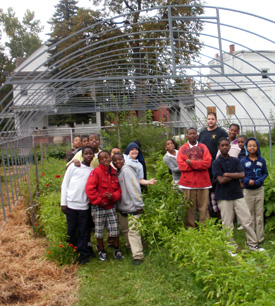Resources
Archived Resources
High Tunnels in Schools
This grant program will be unavailable for 2018-2019. Instead, please consider applying for the new Grow With Us Grant.
About the Project

A partnership between Cornell University's Department of Horticulture and New York Agriculture in the Classroom, the project's goal is to explore how high tunnels in school gardens can maximize garden-based learning and agricultural literacy activities.
Funded with a three year grant (2010-2013), and a three year extension (2013-2016), the project works with 10 schools around the state with exisiting school garden programs. Each school receives site consultation, a high tunnel structure, $1,500 to purchase materials, and program support from the project partners. With the assistance of these pilot sites, we are developing a resource guide for teaching and learning in school-based high tunnels.
For more information on the project, please see below:
- School High Tunnels Blog
- High Tunnel Site and Construction Information Sheet
- High Tunnel Grant Application Overview
High Tunnels in Schools
In recent years, the use of high tunnels (unheated greenhouse structures covered by a single layer of clear polyethylene plastic) to extend the crop growing season by about a month at both ends has become an important part of vegetable, berry and flower production in New York State.
Although widely used by growers, this production technique has not been recognized as relevant to school-based agricultural education (SBAE) or elementary-level education that involves agriculture. Yet in New York State the academic or programmatic calendar for schools does not mesh well with the growing season, and as a result, educators are unable to maximize the potential for garden-based learning and agricultural literacy. They have therefore become increasingly interested in practices that extend the season without the increased cost, expertise and maintenance associated with greenhouse production. We believe that high tunnels could be a desirable technology for educational institutions with the desire to implement and expand on local garden production, and could concurrently provide many desirable educational outcomes.
Extending the Growing Season, Extending Learning Opportunities
Enclosing growing plants in an unheated high tunnel raises temperatures on sunny days significantly, and allows them to grow even when outdoors it would be too cold. At night, some of the accumulated heat carries over, but for best frost protection, a secondary protective layer may be needed over the plants. The protection of the high tunnel also makes it possible to garden while it is raining outside. All of these factors allows the gardening season to be advanced by about 4 weeks in spring, and extended by about 4 weeks in the fall. Choice of cold-tolerant plants for early and late production can extend the season even more. Thus students can be growing leafy greens in spring from sowing to harvest, and enjoy harvesting tomatoes and peppers in the fall even after these crops have been killed by frost outside. Information on crops that can be grown, from leafy greens to fruit-bearing vegetables to raspberries, strawberries and cut flowers, can be found on the Cornell High Tunnel website.
More About the High Tunnel Structure
The structure that is supplied to participating schools is manufactured by Howard Hoover, a vegetable grower near Penn Yan, NY, who has been a pioneer in growing vegetables in high tunnels for many years. The high tunnel is 20 ft. wide, 48 ft. long, and stands about 12 feet tall. Walls and roof are made from square steel, with access to the interior through doors in the end walls. The structure is covered by clear, heavy polyethylene, the same as used as covering materials for greenhouses.
For ventilation, the plastic covering the sides can be rolled up manually, and there may be vents installed in the end walls to further improve air flow. Plants can be grown in the ground in the high tunnel, or in raised beds edged by lumber or other materials. Raised bed culture provides the option of growing in a medium that is different from the soil native to the location of the tunnel, and thus to avoid soil-related problems of drainage, soil acidity and possible harmful residues (lead paint, toxic materials, etc.).
High tunnels rely on natural ventilation, and are normally not heated. Thus it is not necessary to locate the structure near a source of electricity. Since the plastic roof keeps off the rain, some provision must be made to supply water for plant needs. Most commonly, high tunnels are irrigated with trickle tubes that distribute the water to the base of the plants. The water is generally supplied through municipal water systems.
